Burnham Beeches - A ladies game?
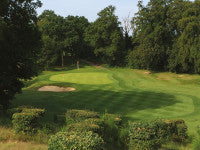
Lee Bishop has been at the historic, parkland course for fifteen years, nine as Course Manager, joining as an assistant in 1998, after being introduced to greenkeeping by Alex Millar, Estate Manager of Stoke Park. Lee was in the building industry and the work dried up so, as a member of Stoke Park, he asked Alex if there was any part time work available and he kindly obliged! Lee hasn't looked back since and thanks Alex for giving him the chance to get his foot on the greenkeeping ladder.
Lee's drive and passion was inspired by his father; "My dad was a hard working man, never complained, cycled five miles to work and back everyday and only ever had one job. He was always pushing me to educate myself, so I would say he inspired me a lot to get where I am today. Along the way, I completed NVQ Level 2 & 3 in sports turf, an HND in Sports Turf Science, A1 Assessors certificate, Chainsaw Licence and PA1, PA2 & PA6."
It may come as some surprise that seventeen of the founding course members were ladies. One of the better known members over the years was Lady Astor, the first woman to take a seat in the House of Commons, who was a member at Burnham from 1930 to 1962, and lived at Cliveden, a couple of miles away. The present-day ladies still play an important role at the club.
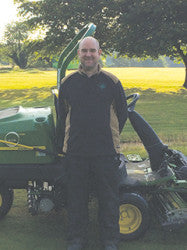
The undulating layout is based on gravel, with anything from four inches to ten inches of indigenous topsoil, with bands of deep clay running through the valley which meanders across the course. The full greens, tees and fairway irrigation ensures good summer playing conditions, made possible with the Rainbird irrigation system installed in 2006. At the same time, a storage reservoir was installed which holds 3.7 million gallons and lasts around sixty days when a full cycle is run.
Greens are traditional push ups and cut with a John Deere 2500E at 2.5mm in summer, 4mm in winter. A few of the tees have been reconstructed but the majority have been in place since 1891 and these, along with the approaches, are cut with a John Deere 2500B at 9mm in summer, 12mm in winter. Fairways are cut with a John Deere 7700 at 14mm in summer, 18mm in winter. Semi-rough is cut with a John Deere 7200 at 25mm all year round. Rough is cut with a John Deere 8800 at 63mm all year.
Lee explained his maintenance regime: "We use plant growth regulators on greens, tees, approaches and fairways using a John Deere HD200 Sprayer mounted on a John Deere 2030A ProGator which is simple to use and ergonomically spot on - it's so accurate, it's scary! With the reduction in growth, this allows us to alternate cutting and rolling (Tru-Turf Turf Iron) whilst keeping the speed consistent. Tees and approaches are cut twice a week with extra cutting prior to our tournaments, which also applies to the fairways. Semi-rough is cut three times a week, as we don't use plant growth regulators on this area. Rough is mown five days a week."
Greens aeration
"We mini core with a 6mm core 50mm deep once in March and again in April with a John Deere Aercore 1500 on the back of a John Deere 3520 Compact tractor on Galaxy tyres which is quick, quiet, smooth and easy to use," Lee continued. "Then a 12mm, 150mm deep pencil tine with a Wiedenmann XF on the back of a Kubota L3050 at the end of April. In an ideal world, I would use a 5mm needle tine every four weeks throughout the summer but, unfortunately, play dictates this and it is not always possible. Our renovation work is carried out the first week in August when we hire a Graden Contour Sand Injection and overseed with browntop bent. During October, we hollow core with another 12mm pencil tine and, if we are lucky, we may get another pencil tine in before the end of the year.
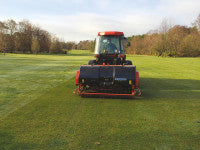
As a result of the all wet weather we've had, Lee has aerated much more and also thinks thatch removal will be high on the agenda this year. "Flexibility is so important! It's not about doing something for the sake of it, but about finding the right opportunity when the ground conditions are right, when you get the most benefit."
Topdressing
"We topdress with a Dakota mounted onto our ProGator. We aim for 150 tonnes a year and use straight sand. 40 tonnes goes down at renovation time and then the majority of the rest we put down in the winter. We use a preventative fungicide programme and plant protection packages throughout the winter for when we topdress. We tend to dress whenever it rains during the winter, as it is washed into the sward quickly and causes less damage to the mowers. Very little topdressing is done throughout the summer as play doesn't allow, however, dressing during winter months has proved very beneficial to us, and means the need for temporary greens is greatly reduced.
"Last year, we finished a three year overseeding programme of fairways and semi-rough around the greens using a three-way dwarf rye mixture. I use this mixture for its wear tolorence, but I do accept that it needs more water and nutrition. For us, the rye grass gives excellent definition between cuts, and also presents sharper cutting patterns." Lee concluded.
Seasonal Renovations
Sand Injection is usually carried out in August. However, this year Lee is hollow coring, due to rising sand costs, which fell outside of his budget set by the board of directors and the general manager. This means Lee will first double scarify with Turf Works cassettes at 5mm-7mm on a John Deere 2500B, then hollow core at 50mm-75mm with a 19mm tine, topdress with kiln dried sand, brush in, seed with browntop bent, then apply the final dressing to top up the holes. Lee is hopeful he will get forty tonnes of kiln dried sand on and into the holes, followed with twenty tonnes of moist sand to top the holes up.

For the second time, all the John Deere equipment is on a five year lease, as well as the blower, turf iron, Allett scarifier and Dakota topdresser which started this January and the Hunter grinders are on a separate lease. Lee commented; "This works well for us as we know our outgoing payments are constant for five years and it greatly helps cash flow. All the other kit we own and replace when needed from our local dealer, Farols."
Lee was keen to boast that, in 2008, the club were the first in the south to have a Grass Grabber installed in order to comply with the washdown area legislation. No bugs, no recycling water. It's simple, low maintainence, cheap to run, easy to use and, according to Lee, costs a fraction of its competitors.
All hands to the pump
Lee and his team of six full time qualified staff, along with two additional part-time summer staff (when required), work on an all hands to the pump approach. Lee explained that he generally carries out all the spraying, but all his lads can do every other task. "I like to rotate the work so no one gets complacent," he commented. "But sometimes, that's difficult if you get one of the guys that especially excels at one task."
"I have one guy who tends to do most of the aeration. He is an early bird and doesn't mind coming in, so we get a good start in font of the golfers. We don't employ a designated workshop technician, but one of my lads knows his way around the machinery pretty well and has attended training courses with both Toro and John Deere. He spends, on average, two days per week in the shed, checking cuts, greasing, grinding and carrying out general maintenance required.
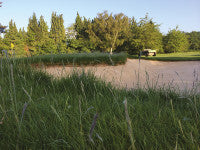
I'm sure we would all agree that it's so hard for the younger generation to find work these days and it's all about giving someone a chance. Lee has just done that by taking the decision to appoint an apprentice instead of two part time summer staff. "This is working really well for us," Lee explained, "as we managed to get a slightly older apprentice who had limited machinery experience. He was cutting rough after week one, which is a bonus as this is so labour intensive. There are a lot of young course managers out there now, which is testament to the clubs giving them a chance and also to the course managers for taking the chance. Education has improved ten fold and, with technology moving along at a brisk pace, ongoing development is paramount and such a positive step for the industry."
As well as the course maintenance, the team tends to two short game greens. One is 400m2 with a bunker and a few mounds to chip over and is generally used for pitching. Golfers can also hit roughly 150 yards on this range. The other is about 150m2 and just used for chipping. The range is situated near the reservoir where golfers can hit a driver.
Pests and diseases
Lee used to contract out pest and weed control on the course. However, he found this quite expensive so now it is done in-house using the HD200 sprayer. This also means he can apply it whenever it's needed rather than on a specific date. The areas are quite small, so spraying can be carried out within five hours.
Rabbits can be a problem on the course but these are controlled by an outside pest control company. However, Lee went on to say that worms are a bit of a pain now that there is not an effective product on the market and sprays the fairways, tees and approaches twice a year with Carbendazim and a penetrant.
Ecology and environment
The course backs on to Burnham Beeches - a large area of ancient woodland, open to the public and designated as a National Nature Reserve and an SSSI site. Naturally, this means that wildlife is in abundance and roe deer, muntjacs, stoats etc. and the very rare wood ants (which are only found in a handful of areas) are often found crossing the boundaries. Despite not having any bird boxes up, due to lack of time to maintain them, there are plenty of red kites and tawny owls.
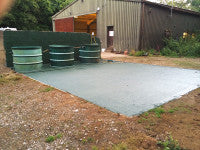
As for future plans, the club are about to enter the second year of a five year bunker project and high on Lee's wish list is an Aston Martin DB5 - "I can picture myself putting the hole changing gear in the boot" he said….. Can't we all!
Maybe Lee's blog he started recently will help him along the way? This is updated every four to six weeks and has proved really popular with members. I took a look and I can see why. It has a wonderful personal touch and is very informative.
As well as keeping in touch via technology, Lee and his team regularly hold demonstration evenings, around the clubhouse and on the putting green, for members to view new machinery followed by a Q&A session and a few pints. Lee commented "I encourage the lads to talk to the members, it's a good way to get feedback, positive and negative on the course, and the very occasional good idea!"
Visit Lee's blog at: burnhamgreenkeepers.weebly.com
